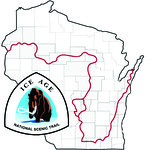Roadside Features
The rock ledge (N44 15.730 W087 40.595) seen along Rockledge Road is an exposed section of the Niagara Escarpment; (see GC1V50D - IATCC BO-DE-WAD-ME Cuesta). The escarpment is the underlying bedrock at the site. It slopes gently downward toward the east (and the cache site) from this location.
The large rock (N44 15.647 W087 39.085) seen on the east side of Princl Road is an erratic, which the glacier moved to and dropped at this location when it receded from the area 10-12,000 years ago.
Site Information
As you walk from Hillview Road south toward the site, you will pass a bench (N44 16.016 W087 39.734). If you sit and enjoy the view for awhile, you can't miss the Thompson Family Maple. It is believed to be the largest Silver Maple in Manitowoc County, possibly Wisconsin.
A seep is a moist or wet place where groundwater, reaches the earth's surface from an underground aquifer.
During a rainstorm, water soaks into the ground. When the water is on a hill, it starts moving along underground layers of soil and rock that are porous enough to allow water to move through it. The water doesn't move straight down into the ground, but rather it moves both downward and horizontally along permeable layers. The water moves "down-gradient" toward a creek or river at the bottom of the hill.
A seep will occur when there is an area partly down-hill that is indented from the rest of the slope so that it cuts into the permeable layer of soil. The groundwater seeps to the surface.


A seep is similar to a spring in that the water comes from underground sources. A seep creates conditions where soils are composed of peat or muck needed for a sedge meadow. A meadow is a closed wetland community composed of perennial forb, grass, and sedge mixtures growing on saturated soils. They are often a transition zone between aquatic communities and uplands. A sedge meadow may grade into shallow marshes, fens, wet prairies, or bogs.
 IATCC is the cache designation to highlight a series of EarthCaches along the Ice Age National Scenic Trail grouped into a special category called "ColdCache."
IATCC is the cache designation to highlight a series of EarthCaches along the Ice Age National Scenic Trail grouped into a special category called "ColdCache."
The Ice Age Trail is one of eleven National Scenic Trails designated by the National Park Service. This unique trail is entirely within the state of Wisconsin and follows along the terminal moraine of the most recent glacier which retreated about 10,000 years ago.
This project is supported by the Ice Age Trail Alliance (IATA). The goal is to bring more visitors to the trail and promote public awareness, appreciation, and understanding of Wisconsin’s glacial landscape.
The IATA has created an awards program to encourage visits to the trail and ColdCache sites. This awards program is separate from, and in addition to, any other Geo- or EarthCache awards program.
A current list of approved ColdCache sites can be found on the “IATCC Bookmark List”. More information on the Ice Age Trail Atlas, the Companion Guide, the ColdCache Project and Awards Program can be found on the “ColdCache Webpage”
DNR Permission
The Geocache Notification Form has been submitted to Guy Willman of the Wisconsin DNR. Geocaches placed on Wisconsin Department of Natural Resource managed lands require permission by means of a notification form. Please print out a paper copy of the notification form, fill in all required information, then submit it to the land manager. The DNR Notification form and land manager information can be obtained at: www.wi-geocaching.com/hiding
Resources
Geology of the Ice Age National Scenic Trail; by David M. Mickelson, Louis J. Mahler Jr., and Susan L. Simpson
Groundwater Basics; Kalkaska County, Michigan
The USGS Water Science School
Wisconsin Wetlands Association
Wikipedia
To claim this find:
NOTES:
The rock cluster waypoint is actually a small exposed section of the Niagara Escarpment.
When you look to the west from the post and small seepage spot waypoints, you are looking toward a sedge meadow.
1. Is the hillside profile more like graphic A or B?
2. When you are at the post and the small seepage spot waypoints, are you downhill or uphill from the sedge meadow? Estimate the elevation change from these spots to the sedge meadow.
3. How does the underlying bedrock and hillside profile explain the location of the sedge meadow?